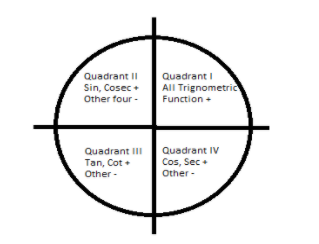Answer
424.5k+ views
Hint: When two lines one real axis and the other imaginary axis passes perpendicular through a circle, the circle is divided into four quadrants. Into Quadrant I where both x and y axis are positive, Quadrant II here x axis is negative and y axis is positive, Quadrant III here both the x axis and y axis are negative and in Quadrant IV x-axis is positive and y-axis is negative.
In case of the trigonometric functions in Quadrant I all the functions are positive, in Quadrant II Sin and Cosec functions are positive and other functions are negative, in Quadrant III tan and cot functions are positive and other are negative and in the case of Quadrant IV Cos and Sec functions are positive and other being negative.

In this question for the given equation we will cofunction identities of the trigonometric function.
Complete step by step solution: \[\sin {15^ \circ } = \cos \left( {n \times {{15}^ \circ }} \right)\]
By the rule of cofunction identity,\[\sin \theta = \cos \left( {{{90}^ \circ } - \theta } \right)\]
We can write as:
\[
\sin \theta = \cos \left( {{{90}^ \circ } - \theta } \right) \\
\sin {15^ \circ } = \cos \left( {{{90}^ \circ } - {{15}^ \circ }} \right) \\
= \cos \left( {{{75}^ \circ }} \right) \\
\\
\]
We can also write, \[\cos \left( {{{75}^ \circ }} \right) = \cos \left( {5 \times {{15}^ \circ }} \right) = \cos \left( {n \times {{15}^ \circ }} \right)\]
Hence, the value of n=5,
Where \[\sin {15^ \circ }\]and \[\cos \left( {{{75}^ \circ }} \right)\]both lie in the Quadrant I where all the trigonometric functions are positive. Quadrant I lie in the range of \[0 - {90^ \circ }\].
Note: The co-function identities show the relationship between the sin, cos, tan, cosine, sec and cot function. The value of the trigonometric function for an angle is equal to the value of the co-function of the complement.
In case of the trigonometric functions in Quadrant I all the functions are positive, in Quadrant II Sin and Cosec functions are positive and other functions are negative, in Quadrant III tan and cot functions are positive and other are negative and in the case of Quadrant IV Cos and Sec functions are positive and other being negative.

In this question for the given equation we will cofunction identities of the trigonometric function.
Complete step by step solution: \[\sin {15^ \circ } = \cos \left( {n \times {{15}^ \circ }} \right)\]
By the rule of cofunction identity,\[\sin \theta = \cos \left( {{{90}^ \circ } - \theta } \right)\]
We can write as:
\[
\sin \theta = \cos \left( {{{90}^ \circ } - \theta } \right) \\
\sin {15^ \circ } = \cos \left( {{{90}^ \circ } - {{15}^ \circ }} \right) \\
= \cos \left( {{{75}^ \circ }} \right) \\
\\
\]
We can also write, \[\cos \left( {{{75}^ \circ }} \right) = \cos \left( {5 \times {{15}^ \circ }} \right) = \cos \left( {n \times {{15}^ \circ }} \right)\]
Hence, the value of n=5,
Where \[\sin {15^ \circ }\]and \[\cos \left( {{{75}^ \circ }} \right)\]both lie in the Quadrant I where all the trigonometric functions are positive. Quadrant I lie in the range of \[0 - {90^ \circ }\].
Note: The co-function identities show the relationship between the sin, cos, tan, cosine, sec and cot function. The value of the trigonometric function for an angle is equal to the value of the co-function of the complement.
Recently Updated Pages
How many sigma and pi bonds are present in HCequiv class 11 chemistry CBSE

Why Are Noble Gases NonReactive class 11 chemistry CBSE

Let X and Y be the sets of all positive divisors of class 11 maths CBSE

Let x and y be 2 real numbers which satisfy the equations class 11 maths CBSE

Let x 4log 2sqrt 9k 1 + 7 and y dfrac132log 2sqrt5 class 11 maths CBSE

Let x22ax+b20 and x22bx+a20 be two equations Then the class 11 maths CBSE

Trending doubts
Fill the blanks with the suitable prepositions 1 The class 9 english CBSE

At which age domestication of animals started A Neolithic class 11 social science CBSE

Which are the Top 10 Largest Countries of the World?

Give 10 examples for herbs , shrubs , climbers , creepers

Difference between Prokaryotic cell and Eukaryotic class 11 biology CBSE

Difference Between Plant Cell and Animal Cell

Write a letter to the principal requesting him to grant class 10 english CBSE

Change the following sentences into negative and interrogative class 10 english CBSE

Fill in the blanks A 1 lakh ten thousand B 1 million class 9 maths CBSE



